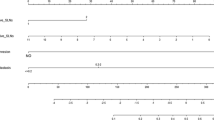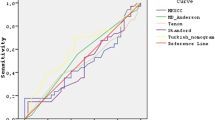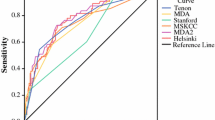Abstract
Objective To assess whether the Memorial Sloan Kettering Cancer Center (MSKCC) nomogram for prediction of NSLN metastasis is useful in a German breast cancer population and whether the characteristics of the breast tumor and the sentinel lymph node (SLN) are able to predict the likelihood of non-sentinel lymph node (NSLN) metastasis. Methods A total of 545 patients with primary breast cancer and SLN examination were evaluated. The MSKCC nomogram was applied to 98 patients with a positive SLN who subsequently had completion axillary lymph node dissection (ALND). Predictive accuracy was assessed by calculating the area under the receiver-operator characteristic (ROC) curve. The collective was evaluated by correlating the prevalence of NSLN and SLN metastasis to pathological features. Results The MSKCC nomogram achieved a ROC of 0.58 indicating a bad accuracy of the nomogram. Tumor size, histology, lymphovascular infiltration, multifocality, Her-2-neu positivity, and nuclear grade correlated with the probability of SLN metastasis. Histology and primary tumor localization correlated significantly with the probability of NSLN metastasis. Conclusions The MSKCC nomogram did not provide a reliable predictive model in our study population. However, the likelihood of SLN metastasis correlated with the presumed risk factors and no obvious differences between the MSKCC population and our population could be seen. In order to achieve interinstitutional reproducibility, standardization of surgical procedure and of the pathological assessment of the SLN is desirable.


Similar content being viewed by others
References
Veronesi U, Paganelli G, Galimberti V, Viale G, Zurrida S, Bedoni M, Costa A, de Cicco C, Geraghty JG, Luini A, Sacchini V, Veronesi P (1997) Sentinel-node biopsy to avoid axillary dissection in breast cancer with clinically negative lymph-nodes. Lancet 349:1864–1867
Wong SL, Edwards MJ, Chao C, Tuttle TM, Noyes RD, Woo C, Cerrito PB, McMasters KM (2001) Predicting the status of the nonsentinel axillary nodes: a multicenter study. Arch Surg 136:563–568
Rahusen FD, Torrenga H, van Diest PJ, Pijpers R, van der Wall E, Licht J, Meijer S (2001) Predictive factors for metastatic involvement of nonsentinel nodes in patients with breast cancer. Arch Surg 136:1059–1063
den Bakker MA, van Weeszenberg A, de Kanter AY, Beverdam FH, Pritchard C, van der Kwast TH, Menke-Pluymers M (2002) Non-sentinel lymph node involvement in patients with breast cancer and sentinel node micrometastasis; too early to abandon axillary clearance. J Clin Pathol 55:932–935
Sachdev U, Murphy K, Derzie A, Jaffer S, Bleiweiss IJ, Brower S (2002) Predictors of nonsentinel lymph node metastasis in breast cancer patients. Am J Surg 183:213–217
Mignotte H, Treilleux I, Faure C, Nessah K, Bremond A (2002) Axillary lymph-node dissection for positive sentinel nodes in breast cancer patients. Eur J Surg Oncol 28:623–626
Nos C, Harding-MacKean C, Freneaux P, Trie A, Falcou MC, Sastre-Garau X, Clough KB (2003) Prediction of tumour involvement in remaining axillary lymph nodes when the sentinel node in a woman with breast cancer contains metastasis. Br J Surg 90:1354–1360
de Widt-Levert L, Tjan-Heijnen V, Bult P, Ruers T, Wobbes T (2003) Stage migration in breast cancer: surgical decisions concerning isolated tumour cells and micro-metastasis in the sentinel lymph node. Eur J Surg Oncol 29:216–220
Abdessalam SF, Zervos EE, Prasad M, Farrar WB, Yee LD, Walker MJ, Carson WB, Burak WE Jr (2001) Predictors of positive axillary lymph nodes after sentinel lymph node biopsy in breast cancer. Am J Surg 182:316–320
Barnwell JM, Arredondo MA, Kollmorgen D, Gibbs JF, Lamonica D, Carson W, Zhang P, Winston J, Edge SB (1998) Sentinel node biopsy in breast cancer. Ann Surg Oncol 5:126–130
Veronesi U, Paganelli G, Viale G, Luini A, Zurrida S, Galimberti V, Intra M, Veronesi P, Robertson C, Maisonneuve P, Renne G, De Cicco C, De Lucia F, Gennari R (2003) A randomized comparison of sentinel-node biopsy with routine axillary dissection in breast cancer. N Engl J Med 349:546–553
Cady B. (1997) Case against axillary lymphadenectomy for most patients with infiltrating breast cancer. J Surg Oncol 66:7–10
Bland KI, Scott-Conner CE, Menck H, Winchester DP (1999) Axillary dissection in breast-conserving surgery for stage I and II breast cancer: a national cancer data base study of patterns of omission and implications for survival. J Am Coll Surg 188:586–595; discussion 595–596
Hwang RF, Krishnamurthy S, Hunt KK, Mirza N, Ames FC, Feig B, Kuerer HM, Singletary SE, Babiera G, Meric F, Akins JS, Neely J, Ross MI. (2003) Clinicopathologic factors predicting involvement of nonsentinel axillary nodes in women with breast cancer. Ann Surg Oncol 10:248–254
Cserni G (2001) Sentinel lymph-node biopsy-based prediction of further breast cancer metastasis in the axilla. Eur J Surg Oncol 27:532–538
Turner RR, Chu KU, Qi K, Botnick LE, Hansen NM, Glass EC, Giuliano AE (2000) Pathologic features associated with nonsentinel lymph node metastasis in patients with metastatic breast carcinoma in a sentinel lymph node. Cancer 89:574–581
Reynolds C, Mick R, Donohue JH, Grant CS, Farley DR, Callans LS, Orel SG, Keeney GL, Lawton TJ, Czerniecki BJ (1999) Sentinel lymph node biopsy with metastasis: can axillary dissection be avoided in some patients with breast cancer? J Clin Oncol 17:1720–1726
Weiser MR, Montgomery LL, Tan LK, Susnik B, Leung DY, Borgen PI, Cody HS 3rd (2001) Lymphovascular invasion enhances the prediction of non-sentinel node metastasis in breast cancer patients with positive sentinel nodes. Ann Surg Oncol 8:145–149
Viale G, Maiorano E, Pruneri G, Mastropasqua MG, Valentini S, Galimberti V, Zurrida S, Maisonneuve P, Paganelli G, Mazzarol G (2005) Predicting the risk for additional axillary metastasis in patients with breast carcinoma and positive sentinel lymph node biopsy. Ann Surg 241:319–325
Degnim AC, Reynolds C, Pantvaidya G, Zakaria S, Hoskin T, Barnes S, Roberts MV, Lucas PC, Oh K, Koker M, Sabel MS, Newman LA (2005) Nonsentinel node metastasis in breast cancer patients: assessment of an existing and a new predictive nomogram. Am J Surg 190:543–550
Van Zee KJ, Manasseh DM, Bevilacqua JL, Boolbol SK, Fey JV, Tan LK, Borgen PI, Cody HS 3rd, Kattan MW (2003) A nomogram for predicting the likelihood of additional nodal metastasis in breast cancer patients with a positive sentinel node biopsy. Ann Surg Oncol 10:1140–1151
Specht MC, Kattan MW, Gonen M, Fey J, Van Zee KJ (2005) Predicting nonsentinel node status after positive sentinel lymph biopsy for breast cancer: clinicians versus nomogram. Ann Surg Oncol 12:654–659
Gipponi M, Bassetti C, Canavese G, Catturich A, Di Somma C, Vecchio C, Nicolò G, Schenone F, Tomei D, Cafiero F (2004) Sentinel lymph node as a new marker for therapeutic planning in breast cancer patients. J Surg Oncol 85:102–111
Varghese P, Mostafa A, Abdel-Rahman AT, Akberali S, Gattuso J, Canizales A, Wells CA, Carpenter R (2007) Methylene blue dye versus combined dye-radioactive tracer technique for sentinel lymph node localisation in early breast cancer. Eur J Surg Oncol 33:147–152
Lambert LA, Ayers GD, Hwang RF, Hunt KK, Ross MI, Kuerer HM, Singletary SE, Babiera GV, Ames FC, Feig B, Lucci A, Krishnamurthy S, Meric-Bernstam F (2006) Validation of a breast cancer nomogram for predicting nonsentinel lymph node metastasis after a positive sentinel node biopsy. Ann Surg Oncol 13:310–320
Degnim AC, Griffith KA, Sabel MS, Hayes DF, Cimmino VM, Diehl KM, Lucas PC, Snyder ML, Chang AE, Newman LA (2003) Clinicopathologic features of metastasis in nonsentinel lymph nodes of breast carcinoma patients. Cancer 98:2307–2315
Soni NK, Carmalt HL, Gillett DJ, Spillane AJ (2005) Evaluation of a breast cancer nomogram for prediction of non-sentinel lymph node positivity. Eur J Surg Oncol 31:958–964
Kocsis L, Svébis M, Boross G, Sinkó M, Maráz R, Rajtár M, Cserni G (2004) Use and limitations of a nomogram predicting the likelihood of non-sentinel node involvement after a positive sentinel node biopsy in breast cancer patients. Am Surg 70:1019–1024
Alran S, De Rycke Y, Fourchotte V, Charitansky H, Laki F, Falcou MC, Benamor M, Freneaux P, Salmon RJ for the Institut Curie Breast Cancer Study Group, Sigal-Zafrani B (2007) Validation and limitations of use of a breast cancer nomogram predicting the likelihood of non-sentinel node involvement after positive sentinel node biopsy. Ann Surg Oncol 14:2195–2201
Smidt ML, Kuster DM, van der Wilt GJ, Thunnissen FB, Van Zee KJ, Strobbe LJ (2005) Can the Memorial Sloan-Kettering Cancer Center nomogram predict the likelihood of nonsentinel lymph node metastasis in breast cancer patients in the Netherlands? Ann Surg Oncol 12:1066–1072
Ponzone R, Maggiorotto F, Mariani L, Jacomuzzi ME, Magistris A, Mininanni P, Biglia N, Sismondi P (2007) Comparison of two models for the prediction of nonsentinel node metastasis in breast cancer. Am J Surg 193:686–692
Zgajnar J, Perhavec A, Hocevar M, Podkrajsek M, Hertl K, Frkovic-Grazio S, Pohar M, Besic N (2007) Low performance of the MSKCC nomogram in preoperatively ultrasonically negative axillary lymph node in breast cancer patients. J Surg Oncol 96:547–553
Pal A, Provenzano E, Duffy SW, Pinder SE, Purushotham AD(2007) A model for predicting non-sentinel lymph node metastatic disease when the sentinel lymph node is positive. Br J Surg: Epub ahead of print
Cripe MH, Beran LC, Liang WC, Sickel-Santanello B (2006) The likelihood of additional nodal disease following a positive sentinel lymph node biopsy in breast cancer patients: validation of a nomogram. Am J Surg 192:484–487
Aihara T, Munakata S, Morino H, Takatsuka Y (2004) Comparison of frozen section and touch imprint cytology for evaluation of sentinel lymph node metastasis in breast cancer. Ann Surg Oncol 11:747–750
Benson JR, della Rovere GQ, Axilla Management Consensus Group (2007) Management of the axilla in women with breast cancer. Lancet Oncol 8:331–348
Cody HS 3rd (2003) Sentinel lymph node biopsy for breast cancer: does anybody not need one? Ann Surg Oncol 10:1131–1132
Liberman L (2000) Pathologic analysis of sentinel lymph nodes in breast carcinoma. Cancer 88:971–977
Naik AM, Fey J, Gemignani M, Heerdt A, Montgomery L, Petrek J, Port E, Sacchini V, Sclafani L, VanZee K, Wagman R, Borgen PI, Cody HS 3rd (2004) The risk of axillary relapse after sentinel lymph node biopsy for breast cancer is comparable with that of axillary lymph node dissection: a follow-up study of 4008 procedures. Ann Surg 240:462–468; discussion 468–471
Martin RC, Derossis AM, Fey J, Yeung H, Yeh SD, Akhurst T, Heerdt AS, Petrek J, VanZee KJ, Montgomery LL, Borgen PI, Cody HS 3rd (2001) Intradermal isotope injection is superior to intramammary in sentinel node biopsy for breast cancer. Surgery 130:432–438
Veronesi U, Salvadori B, Luini A, Banfi A, Zucali R, Del Vecchio M, Saccozzi R, Beretta E, Boracchi P, Farante G et al (1990) Conservative treatment of early breast cancer. Long-term results of 1232 cases treated with quadrantectomy, axillary dissection, and radiotherapy. Ann Surg 211:250–259
Louis-Sylvestre C, Clough K, Asselain B, Vilcoq JR, Salmon RJ, Campana F, Fourquet A (2004) Axillary treatment in conservative management of operable breast cancer: dissection or radiotherapy? Results of a randomized study with 15 years of follow-up. J Clin Oncol 22:97–101
Chua B, Ung O, Boyages J (2002) Competing considerations in regional nodal treatment for early breast cancer. Breast J 8:15–22
Bevilacqua JL, Kattan MW, Fey JV, Cody HS 3rd, Borgen PI, Van Zee KJ (2007) Doctor, what are my chances of having a positive sentinel node? A validated nomogram for risk estimation. J Clin Oncol 25:3670–3679
Author information
Authors and Affiliations
Corresponding author
Rights and permissions
About this article
Cite this article
Klar, M., Jochmann, A., Foeldi, M. et al. The MSKCC nomogram for prediction the likelihood of non-sentinel node involvement in a German breast cancer population. Breast Cancer Res Treat 112, 523–531 (2008). https://doi.org/10.1007/s10549-007-9884-1
Received:
Accepted:
Published:
Issue Date:
DOI: https://doi.org/10.1007/s10549-007-9884-1




